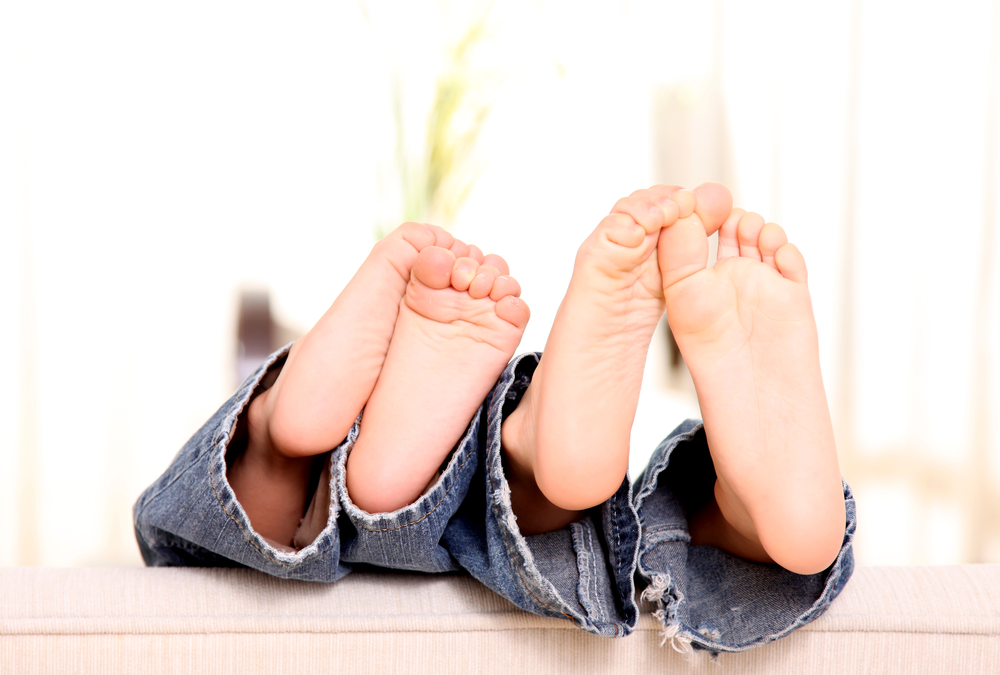There are many different foot shapes, ranging from very arched to average to flat. While all of them can be normal, flat feet sometimes present a problem if they cause pain or affect the way the person walks. If you have noticed that your child’s feet are flat, you can see your local podiatrist in Victoria, Kelowna, or Nanaimo to find out whether they will develop normally or whether they need some assistance.
Your doctor is likely to look at your child’s feet first, then perform some additional diagnostic tests such as an X-ray to make sure that the bones are growing well. Sometimes, they might recommend that you change the shoes your child wears or buy some orthotics that can support normal development. The corrective measures will be determined by your child’s age, as flatter feet are normal in toddlers and younger children.
Are Your Child’s Flat Feet a Problem?
Reduced or missing arches in the feet are very common and can affect up to 30% of the population, but they only cause an issue for about one in ten people who are affected. Sometimes, they are caused by issues such as obesity or an injury, but many people are simply born with a flatter foot shape.
Because the vast majority of people don’t experience problems with flat arches, your child is likely to develop well without intervention. What’s more, almost all babies and toddlers have flat arches because their structures aren’t yet developed. As children grow older, some start to develop painful symptoms. If this is the case, you should seek out medical treatment as soon as possible.
Babies and Toddlers
Many babies are born with low or flat arches, and the condition might persist into toddlerhood and childhood. This is because the bones and joints of young children are very flexible, so the feet flatten when they stand up. Babies also have a fat pad on the inside of their foot that can hide the arch. All of this is normal, although it can appear worrying at first. To check whether your baby has an arch, you can lift them on their toes, and it will become visible.
Young Children
Around the age of five or six, most children will develop an arch. Around two out of ten might remain flat-footed, but as mentioned, this isn’t a concern unless you notice that your child has pain when walking or doesn’t seem to be moving normally. You should never buy arch supports or shoe inserts for children with flat arches because they won’t change the shape of the foot and might do some damage.
When to See a Podiatrist in Victoria, Kelowna, or Nanaimo
If you notice that your child has flat arches even after the age of six, it might be worth visiting a foot doctor to make sure that their development is normal. There are certain forms of flat arches that can be treated easily, for example when a tightness in the Achilles tendon is the cause. By encouraging them to perform some simple stretching exercises, you may be able to help your child to develop their arches.
Occasionally, a child has rigid arches, which happens when the movement of the foot up and down and side to side is limited. Any time you notice soreness or pressure areas on the child’s foot, reduced foot movement, or stiffness, contact your doctor and set up an appointment. This condition can be painful and cause postural problems, and it can lead to arthritis later in life. In most cases, rigid feet don’t present themselves until later childhood or the teenage years.
How Can Your Foot Doctor Help?
Now that you know when to contact your clinic, you might wonder about what happens when you get to your podiatrist’s office in Victoria, Kelowna, or Nanaimo. In most cases, your child will first be examined, and you will be asked about the symptoms and when you first noticed them. Then, your doctor will let you know whether any corrective measures are necessary and what you should do at home to improve the situation.
Sometimes, you might be told to purchase arch supports or change your child’s shoes. Very rarely, your foot doctor might recommend surgery, for example when your child has trouble walking and is therefore excluded from many activities their peers participate in.
Perform an Analysis
First, your child will be examined so that the doctor can make an accurate diagnosis. They might look at your child’s feet, touch them to find out where they hurt and move them around to see whether mobility is normal. If necessary, an X-ray, bone scan, or another type of imaging study can be ordered. This could help your child’s doctor to find out more about what the problem is and what types of corrections could be appropriate.
Recommend Supportive Shoes
Supportive shoes or inserts, either ones available at the pharmacy or ones that are custom made for your child, can be a viable solution for many children and young adults. Keep in mind that you should never purchase these types of products on your own because the wrong support can make the problem worse and cause your child more pain. Instead, always get your foot doctor’s opinion before making a decision.
Recommend Physiotherapy
Pediatric physiotherapy aims to treat issues that affect the growth and development of children. Your doctor might recommend a physio who can help your child to perform stretches that lengthen the Achilles tendon or show them how they should walk to avoid problems. There are many physiotherapists who specialize in working with young patients. You can get a recommendation from your doctor, who will know the best professional for your child.
Surgery
Sometimes, your child’s flat or rigid feet can have a significant impact on their life. If they have trouble walking even short distances, running, and playing with their friends, it might be worth considering surgery so that they can enjoy physical activities. Additionally, you can prevent problems such as arthritis, nerve entrapment, or bunions that could affect your child later in life.
Depending on what the issue is, different types of surgery might be necessary. The foot’s arch can be recreated surgically, and fused bones can be separated through a process called resection surgery. However, we will usually try to address issues with more holistic methods first and only consider surgery if all other interventions can’t resolve the problem.
Flat feet in children are no reason to be concerned unless there is pain or your child is unable to walk normally. Babies and toddlers almost always have flat arches because the foot only develops and gains in strength as they become older. However, if you are concerned that there is an issue, you can get in touch with a local podiatrist in Victoria, Kelowna, or Nanaimo, who can perform diagnostic tests and recommend corrective measures if necessary.
Call or message us at Island Foot Clinics Podiatric Group to book an appointment with one of our specialists. When it comes to treating foot problems, we will always use the least invasive method possible, and we will take the developmental stage of your child into consideration. While flat arches aren’t generally of concern, it can be worth a trip to the clinic to make sure that your child’s feet are developing normally.

